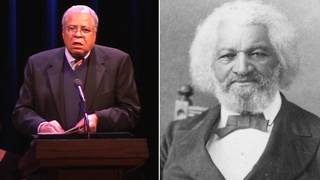
Guests
- Ta-Nehisi Coatesis a national correspondent at The Atlantic, where he writes about culture, politics and social issues. He has just written a cover story for the magazine called “The Case for Reparations.” Coates is also the author of the memoir The Beautiful Struggle.
An explosive new cover story in the June issue of The Atlantic magazine by the famed essayist Ta-Nehisi Coates has rekindled a national discussion on reparations for American slavery and institutional racism. Coates explores how slavery, Jim Crow segregation, and federally backed housing policy systematically robbed African Americans of their possessions and prevented them from accruing intergenerational wealth. Much of the essay focuses on predatory lending schemes that bilked potential African-American homeowners, concluding: “Until we reckon with our compounding moral debts, America will never be whole.” Click here to watch Part 2 of this interview.
Transcript
AMY GOODMAN: “The Case for Reparations. Two hundred fifty years of slavery. Ninety years of Jim Crow. Sixty years of separate but equal. Thirty-five years of racist housing policy. Until we reckon with our compounding moral debts, America will never be whole.”
So begins an explosive new cover story in the June issue of The Atlantic magazine by the famed essayist Ta-Nehisi Coates. The article is being credited for rekindling a national discussion on reparations for American slavery and institutional racism.
JUAN GONZÁLEZ: In the essay, Ta-Nehisi Coates exposes how slavery, Jim Crow, segregation and federally backed housing policy systematically robbed African Americans of their possessions and prevented them from accruing intergenerational wealth. Much of the piece focuses on predatory lending schemes that bilked potential African-American homeowners. This is a video that The Atlantic released to preview its new cover story, “The Case for Reparations.”
BILLY LAMAR BROOKS SR.: This area here represents the poorest of the poor in the city of Chicago.
MATTIE LEWIS: I’ve always wanted to own my own house, because I worked for white people when I was in the South, and they had beautiful homes, and I always said, one day I was going to have me one.
JACK MacNAMARA: White folks created the ghetto. And it drives me crazy today even that we don’t admit that. This is the best example I can think of of institutional racism.
JUAN GONZÁLEZ: Well, to talk about the case for reparations, we’re joined now by Ta-Nehisi Coates here in New York City.
Welcome to Democracy Now!
TA-NEHISI COATES: Thanks so much for having me.
JUAN GONZÁLEZ: You start your article with one particular figure, Clyde Ross.
TA-NEHISI COATES: Yes.
JUAN GONZÁLEZ: Tell us his story and why you decided to begin with him.
TA-NEHISI COATES: Well, Mr. Ross is really just emblematic of much of what’s happened to African Americans across the 20th—and I emphasize 20th—century. Mr. Ross was born in the Delta region of Mississippi. His family was not particularly poor; they were actually quite prominent farmers. They had their land and virtually all of their possessions taken from them through a scheme around allegedly back taxes and were reduced to sharecropping. In the sharecropping system, there was no sort of assurances over what they might get versus what they actually picked.
When I first met Mr. Ross, the first thing he said to me was he left Mississippi for Chicago because he was seeking the protection of the law. And I didn’t quite understand what he meant by that, but as he explained it to me, he said, “Listen, there were no black judges, no black prosecutors, no black police. Basically, we had no law. We were outlaws. People could take from us whatever they wanted.” And that was very much his early life.
He went to Chicago thinking things would be a little different. And on the—you know, on the surface, they were. He managed to get a job. He got married. He had a decent life and was basically looking for that, you know, one more emblem of the American middle class in the Eisenhower years, and that was the possession of a home.
Unfortunately, due to government policy, Mr. Ross at that time, like most African Americans around the country, was unable to secure a loan, due to policies around redlining and deciding, you know, who deserved the loans and who doesn’t. There was a broad, broad consensus that African Americans, for no other reason besides blanket racism, could not be responsible homeowners.
Mr. Ross, as happens when people are pushed out of the legitimate loan market, ended up in the illegitimate loan market and got caught up in a system of contract buying, which is essentially just a particularly onerous rent-to-own scheme for people looking to buy houses, and ended up purchasing a house, I believe at $27,000, I think, he paid for it. The person who sold it to him had bought the house only six months before for $12,000. And Mr. Ross later became an activist, helped formed the Contract Buyers League, and just fought on behalf of African-American homeowners on the West Side of Chicago. I should add that it’s estimated during this period that 85 percent of African Americans looking to buy homes in Chicago bought through contract lending.
JUAN GONZÁLEZ: Well, let’s hear Clyde Ross in his own words, speaking in 1969 on behalf of the Contract Buyers League, a coalition of black homeowners on Chicago’s South and West Sides, all of whom had been locked into the same system of predatory lending.
CLYDE ROSS: Who have cheated us out of more than money. We have been cheated out of the right to be human beings in a society. We have been cheated out of buying homes at a decent price. Now, it’s time now. We’ve got a chance now. The Contract Buyers League have presented a chance for these people in this area to move out of this grip of society, to move up, stand on your own two feet, be human beings, fight for what you know is right. Fight!
AMY GOODMAN: Ta-Nehisi Coates, can you talk about this example, and others in this remarkable piece, and how you then talk about the bill for reparations that’s been introduced by John Conyers year after year in the House, and what reparations would actually look like?
TA-NEHISI COATES: What I tried to establish in this piece was that there’s a conventional way of talking about the relationship in America between the African-American community and the white community, and it’s one that we’re very comfortable with, and I call it basically the lunch table view of the problem with racism in America, is that black people want to sit at one lunch table and white people want to sit at, you know, another lunch table, and if we could just get black and white people to like each other, love each other, everything would be solved.
In fact, even these terms that we’re using—black and white—are inventions, and they’re inventions of racism. And if you trace back the history back to 1619, a better way of describing the relationship between black and white people is one of plunder, the constant stealing, the taking from black people that extends from slavery up through Jim Crow policy—I mean, slavery is obviously the stealing of people’s labor; in some cases, the outright theft of people’s children and the vending of people’s children, the taking of the black body for whatever profit you can wring from it—up through the Jim Crow South, where you have a system of debt peonage, sharecropping, which really isn’t much different—minus the actual selling of children, you’re still exploiting labor and taking as much as you can from it—into a system—when you think about something like separate but equal, in the civil rights movement, we traditionally picture, you know, colored-only water fountains, white-only restrooms. But the thing people have to remember is, if you take a state like Mississippi or anywhere in the Deep South where you have a public university system, black people are paying into that. Black people are pledging their fealty to the state, and yet they aren’t getting the same return. This is theft. It’s systemized.
And when we try to talk about the practicality of it—I spent 16,000 words, almost, just trying to actually make the case. And at the end, what I come to is that, you know, the actionable thing right now is to support Representative John Conyers’ bill, H.R. 40, for a study of what slavery has actually done, what the legacy of slavery has actually done to black people and what are remedies we might come up with. And I did that not so much to dodge the question, but because I think to actually even sketch out what this might be would take another 16,000 words. I mean, we have to calculate what slavery was. We have to calculate what Jim Crow was. We have to calculate what we lost in terms of redlining, come to some sort of ostensible number and then figure out whether we can actually pay it back, and if we can’t, what we might do in lieu of that.
JUAN GONZÁLEZ: And when you mention the systemic plunder that’s occurred, I mean, this is not ancient history. This—
TA-NEHISI COATES: No, no, it’s not.
JUAN GONZÁLEZ: In the most recent—
TA-NEHISI COATES: No, no.
JUAN GONZÁLEZ: —economic crisis in the country, there was this enormous reduction in the wealth—
TA-NEHISI COATES: Right.
JUAN GONZÁLEZ: —of African Americans in the country as a result of the housing crisis. And yet the narrative portrays it as, well, the housing crisis was caused—the conservative narrative is—
TA-NEHISI COATES: Right.
JUAN GONZÁLEZ: —by affirmative action policies of Fannie Mae and Freddie Mac to make it easier—
TA-NEHISI COATES: Right.
JUAN GONZÁLEZ: —for African Americans with low credit to get loans. Talk about that and this enormous wealth loss that occurred recently.
TA-NEHISI COATES: Right. Well, the great sociologist Douglas Massey has a very interesting paper out specifically about, you know, the foreclosure crisis—it should be rightly called—that happened very, very recently. And one of the things he demonstrates in the paper is the thing that made this possible, segregation was a driver of this. And if you think about it, you know, it makes perfect sense. In the African-American community—the African-American community is the most segregated community in the country, and what you have in that community is a population of people who have been traditionally cut off from wealth-building opportunities, so, anxious to get wealth-building opportunities. If you are a banker and you are looking sell a scheme to somebody and rip somebody off, well, there your marks are, right there, right in the same place. And that’s essentially what happened.
AMY GOODMAN: Ta-Nehisi, I wanted to go to this issue of reparations and the examples you’ve seen—for example, after the Holocaust, Germany and the Jews. Can you talk about how those reparations took place?
TA-NEHISI COATES: Well, it’s very, very interesting. I mean, one of the reasons why I included that history, because, as we know, reparations for African Americans has all sorts of practical problems that we would have to deal with and have to fight about, and I wanted to just demonstrate that even in the case of, you know, reparations to Israel, the one that’s most cited, this was not a sure thing. One of the things that people often say about African-American reparations is, “Well, oh, you’re just talking about slavery. That was so long ago,” as though if, you know, we were talking about a more proximate or more present case, it would be much easier. But, in fact, the fact that it was so close made it really, really hard for people. It made it hard for some Israelis who didn’t want to feel like they were taking a buck off of, you know, folks’ mothers or brothers or sisters or grandmas who had just been killed. In Germany, in fact, you know, if we look at the public opinion surveys at the time, they were no more—Germans, in the popular sense, were no more apt to take responsibility today than Americans are for slavery. So, it was a very, very difficult piece.
What’s interesting, and I think one of the lessons that can be learned from it, however, is the way it was structured. In fact, Germany didn’t just cut a check to Israel. What they actually did was they gave them vouchers. And those vouchers, you know, that were worth a certain amount of money—and those vouchers had to be used with German companies. So, essentially, what they structured was a stimulus for West Germany while giving reparations to Israel at the same time. And it gives us some clue at, you know, some sort of creative solutions we might have in the African-American community.
JUAN GONZÁLEZ: Now, one of the issues you also raise is that this reparations demand is not new in American history itself.
TA-NEHISI COATES: No.
JUAN GONZÁLEZ: You talk about Belinda Royall, who in 1783—
TA-NEHISI COATES: Right.
JUAN GONZÁLEZ: —had been a slave for 50 years, became a freed woman. She petitioned the commonwealth of Massachusetts for reparations.
TA-NEHISI COATES: Right. Right, right, right. And I think people think of this as something that just sort of came up, you know, 150 years—black people—you know, reparations is basically as old as this country is. And it’s not just, as you mention, Belinda Royall, people like that, but it’s also white people who understood at the time that some great injury had been done. Many of the Quaker meetings, for instance, basically, you know, would excommunicate people who didn’t just free their slaves, but actually gave them something, you know, paid them reparations in return. We have, you know, the great quote from Timothy Dwight, who was the president of Yale, who says, “Listen, to liberate these folks, to free these folks and to give them nothing would be to entail a curse upon them.” And effectively, that’s actually what happened, you know, upon African Americans and really, I would argue, upon the country at large. Many, many people of the Revolutionary generation, the generation that fought in the Revolutionary War, understood that slavery was somehow in contradiction to what America was saying it was. And many of those folks also, at the very least, gave land to African Americans when they were liberated. Some of them educated them. But they understood to just cut somebody out into the wild, which is basically what happened to black people, would not be a good thing.
AMY GOODMAN: Ta-Nehisi Coates, we want to thank you very much for being with us. We’re going to do part two right after the show, and we will post it online at democracynow.org. Ta-Nehisi Coates is a national correspondent at The Atlantic, where he writes about culture, politics and social issues, has just written the cover story called “The Case for Reparations.” Ta-Nehisi Coates is also the author of the memoir, The Beautiful Struggle.












Media Options